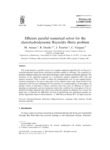Mostrar o rexistro simple do ítem
Efficient Parallel Numerical Solver for the Elastohydrodynamic Reynolds–Hertz Problem
| dc.contributor.author | Arenaz Silva, Manuel | |
| dc.contributor.author | Doallo, Ramón | |
| dc.contributor.author | Touriño, Juan | |
| dc.contributor.author | Regueiro, Carlos V. | |
| dc.date.accessioned | 2019-02-15T18:05:08Z | |
| dc.date.available | 2019-02-15T18:05:08Z | |
| dc.date.issued | 2001-12-01 | |
| dc.identifier.citation | M. Arenaz, R. Doallo, J. Touriño, C. Vázquez, Efficient parallel numerical solver for the elastohydrodynamic Reynolds–Hertz problem, Parallel Computing, Volume 27, Issue 13, 2001, Pages 1743-1765, ISSN 0167-8191, https://doi.org/10.1016/S0167-8191(01)00110-7. | es_ES |
| dc.identifier.issn | 0167-8191 | |
| dc.identifier.issn | 1872-7336 | |
| dc.identifier.uri | http://hdl.handle.net/2183/21812 | |
| dc.description | This is a post-peer-review, pre-copyedit version of an article published in Parallel Computing: systems & applications. The final authenticated version is available online at: https://doi.org/10.1016/S0167-8191(01)00110-7 | es_ES |
| dc.description.abstract | [Abstract] This work presents a parallel version of a complex numerical algorithm for solving an elastohydrodynamic piezoviscous lubrication problem studied in tribology. The numerical algorithm combines regula falsi, fixed point techniques, finite elements and duality methods. The execution of the sequential program on a workstation requires significant CPU time and memory resources. Thus, in order to reduce the computational cost, we have applied parallelization techniques to the most costly parts of the original source code. Some blocks of the sequential code were also redesigned for the execution on a multicomputer. In this paper, our parallel version is described in detail, execution times that show its efficiency in terms of speedups are presented, and new numerical results that establish the convergence of the algorithm for higher imposed load values when using finer meshes are depicted. As a whole, this paper tries to illustrate the difficulties involved in parallelizing and optimizing complex numerical algorithms based on finite elements. | es_ES |
| dc.description.sponsorship | Xunta de Galicia; XUGA 32201B97 | es_ES |
| dc.description.sponsorship | Gobierno de España; CICYT 1FD97-0118-C02 | es_ES |
| dc.description.sponsorship | Gobierno de España; D.G.E.S PB96-0341-C02 | es_ES |
| dc.language.iso | eng | es_ES |
| dc.publisher | Elsevier BV * North-Holland | es_ES |
| dc.relation.uri | https://doi.org/10.1016/S0167-8191(01)00110-7 | es_ES |
| dc.rights | Atribución-NoComercial-SinDerivadas 3.0 España | es_ES |
| dc.rights.uri | http://creativecommons.org/licenses/by-nc-nd/3.0/es/ | * |
| dc.subject | Elastohydrodynamic lubrication | es_ES |
| dc.subject | High-Performance computing | es_ES |
| dc.subject | Finite elements | es_ES |
| dc.subject | Parallel numerical algorithm | es_ES |
| dc.title | Efficient Parallel Numerical Solver for the Elastohydrodynamic Reynolds–Hertz Problem | es_ES |
| dc.type | info:eu-repo/semantics/article | es_ES |
| dc.rights.access | info:eu-repo/semantics/openAccess | es_ES |
| UDC.journalTitle | Parallel Computing: systems & applications | es_ES |
| UDC.volume | 27 | es_ES |
| UDC.issue | 13 | es_ES |
| UDC.startPage | 1743 | es_ES |
| UDC.endPage | 1765 | es_ES |
| dc.identifier.doi | 10.1016/S0167-8191(01)00110-7 |
Ficheiros no ítem
Este ítem aparece na(s) seguinte(s) colección(s)
-
GI-GAC - Artigos [180]






